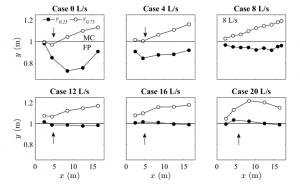Problematic issue
The aim is to study the hydrodynamic complexity of overflowing river flows, which are also called flows in a compound open-channel, consisting of a main channel and adjacent floodplains. Since 2014, research has focused on the impact of floodplain land use on extreme flood flows, particularly in the context of the ANR FlowRes project (2015-2018).
Scientific issues
- Impact of variations in the floodplain land use on the flow structure (time-averaged streamwise velocity, secondary currents, turbulence statistics, and coherent structures) in main channel and floodplain.
- What drives the emergence of large horizontal coherent structures within the planform shear layer between main channel and floodplain (bearing in ming that theses structures have a strong impact on the river flow conveyance)?
- Effect of unsteady flow conditions on the water levels and river flow conveyance (difference between rising and falling limbs).
Methodology
We rely on laboratory experiments in a wide flume (photos below), on a field case (floods on the Doubs river in Besançon), on 1D, 2D and 3D numerical modelling with industrial or research codes.
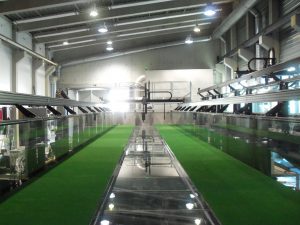
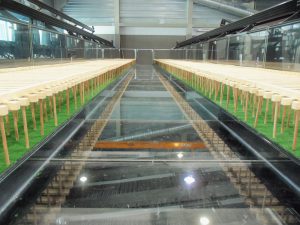
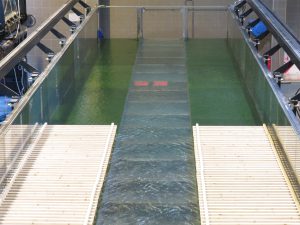
Wide flume with a compound open-channel configuration (central main channel + two adjacent floodplains) and various land uses of the floodplains: meadow model, i.e. dense artificial ‘grass’; tree models. PhD of V. Dupuis (2013-2016)
Example of experimental result
Effects of transverse currents on the shear layer (based on mean velocity distribution): half the mixing layer width, δ / 2, with δ = 2 (y0.75–y0.25). Arrow indicates the direction of transverse currents. Proust and Nikora (2020)
Example of numerical result
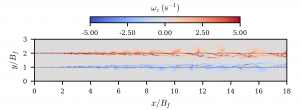
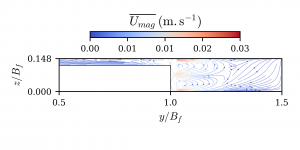
Simulations of non-uniform flows in compound open-channel using the Open FOAM code, with SAS K-Omega SST turbulence model: (top) vertical axis vorticity; (bottom) helical secondary currents. Post-doctorate of M. Chatelain (2017-2018). Figures after Chatelain and Proust (2020)
Research project
ANR FLOWRES project (2015-2018). ‘Predicting the flow in the floodplains with evolving land occupations during extreme flood events’
Partners
French:
Irstea Lyon-Villeurbanne, Institut National des Sciences Appliquées de lyon, Institut de Mécanique des Fluides de Toulouse, Laboratoire d’Hydraulique Saint-Venant.
Foreign:
Instituto Superior Técnico (Lisbon, Portugal), Université y Agder (Grimstad, Norway), Université catholique de Louvain-la-Neuve (Belgium), Service Public de Wallonie (Direction des Recherches Hydrauliques, Châtelet, Belgium), Karlsruhe Institut of Technology (Germany), École Nationale Polytechnique d’Alger (Algeria), National Institute of Technology of Rourkela (India), Aberdeen University (United Kingdom).
PhD theses and post-doctorates
- January 2013 – June 2016: PhD of Victor Dupuis entitled : ‘Experimental investigation of flows subjected to a longitudinal transition in hydraulic roughness in single and compound channels’. PhD Université de Lyon, École Doctorale ED162. Co-supervised by S. Proust, C. Berni, and A. Paquier (director)
- March 2017 – August 2018: Post-doctorate of Marc Chatelain entitled ‘3D LES (Large Eddy Simulation) of floodplain flows in the presence of emergent and slightly submerged macro-roughness elements’. Supervised by S. Proust.
- October 2017 – September 2020: PhD of Yassine Kaddi entitled ‘1D+ Modelling (ISM) of a complex hydraulic network. Application to the operational forecasting of high flow events and floods related to the sizing of civil engineering structures.’ Supervised by: FX Cierco (CNR), JB Faure (Irstea), S. Proust (director).
Publications
- DUPUIS, V. – 2016. Experimental investigation of flows subjected to a longitudinal transition in hydraulic roughness in single and compound channels. Thèse de doctorat, spécialité : Mécanique des fluides, Université Lyon I Claude Bernard. 141 p.
- DUPUIS, V., PROUST, S., BERNI, C., PAQUIER, A. – 2017. Mixing layer development in compound channel flows with submerged and emergent rigid vegetation over the floodplains. Experiments in Fluids, vol. 58, n° 30, 18 p.
- PROUST, S., FERNANDES, J.N., LEAL, J.B., RIVIERE, N., PELTIER, Y. – 2017. Mixing layer and coherent structures in compound channel flows: effects of transverse flow, velocity ratio and vertical confinement . Water Resources Research, vol. 53, n° 4, p. 3387-3406.
- DUPUIS, V., PROUST, S., BERNI, C., PAQUIER, A. – 2017. Compound channel flow with a longitudinal transition in hydraulic roughness over the floodplains. Environmental Fluid Mechanics, vol. 17, n° 5, p. 903-928
- PROUST, S., NIKORA, V.I. – 2018. Flow structure in compound open-channel flows in the presence of transverse currents. River Flow 2018: 9th International Conference on Fluvial Hydraulics. Lyon, France, EDP sciences.
- DAS, B. S., DEVI, K., PROUST, S., KHATUA, K. K. – 2018. Flow distribution in diverging compound channels using improved independent subsection method. River Flow 2018: 9th International Conference on Fluvial Hydraulics. . Lyon, France, EDP Sciences
- KHUNTIA, J.R., DEVI, K., PROUST, S., KHATUA, K.K. – 2018. Depth-averaged velocity and bed shear stress in unsteady open channel flow over rough bed. River Flow 2018: 9th International Conference on Fluvial Hydraulics. Lyon, France, EDP sciences.
- PROUST, S., NIKORA, V.I. – 2020. Compound open-channel flows: Effects of transverse currents on the flow structure. Journal of Fluid Mechanics, 885, A24. doi:10.1017/jfm.2019.973
- CHATELAIN, M., PROUST, S. – 2020. Non-uniform flows in a compound open-channel: assessment of a hybrid RANS – LES approach. Water Resources Research. 56(9). https://doi.org/10.1029/2020WR027054

